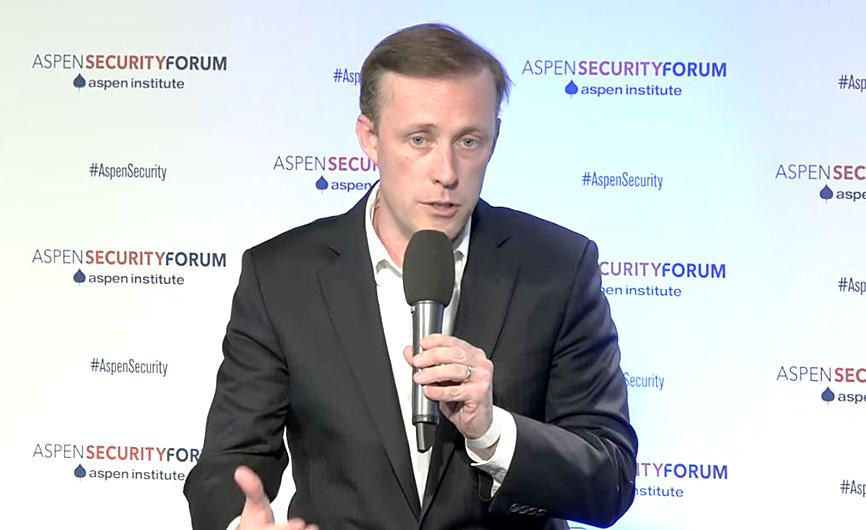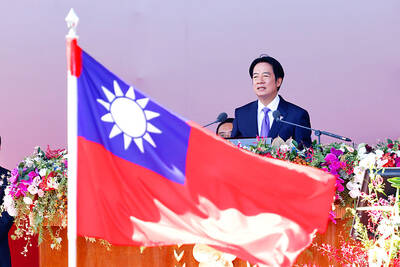The US’ policy is to help Taiwan focus on obtaining the capabilities it needs the most to repel a possible Chinese attack and not the weapon systems it is accustomed to having, a senior US official said on Friday.
US National Security Adviser Jake Sullivan made the remark at the Aspen Security Forum in Colorado after being asked if US President Joe Biden’s “porcupine strategy” has prepared Taiwan to defend itself “right now.”
“We are focused on those capabilities that are going to be most useful in the kinds of contingency we can expect, and not just rely on systems that... [Taiwan has] had around for a very long time,” he said.

Photo: Screen grab from the forum’s video footage
Asked whether Russia’s war in Ukraine could drain the US’ supply of arms to Taiwan, Sullivan said that there are “some overlaps” in the weapons systems required by the two situations.
However, a major contrast exists between Taiwan and Ukraine due to “the nature of the contingency or conflict [being] quite different from [a] land war in Europe and a potential contingency or conflict across the Taiwan Strait,” he said.
Washington’s continued support of the two countries would require increased investment, workforce development and an emphasis on bolstering the supply of key components and weapon systems, he said.
The Ukraine war has not prompted Beijing to fundamentally rethink its approach to Taiwan, but it has learned some concerning lessons about invading another country, he said.
However, Taiwan is also “working rapidly” to learn about mobilization, territorial defense and information warfare from Ukraine, he said.
Asked whether Biden’s statement in May that the US would defend Taiwan represents a shift in Washington’s policy, Sullivan said: “The president said in Japan that our policy has not changed, that we maintain a policy of strategic ambiguity, and we do.”
“Ambiguity has to be a feature of strategy in certain contexts, particularly very complex concepts,” he said. “I will stand to defend that idea conceptually.”
The US’ stance on its relationship with Taiwan continues to governed by the one China policy,” the Three Joint Communiques, the “six assurances” and the Taiwan Relations Act, he said.
Regarding competition between the US and China, Sullivan said that the US has become “well-positioned” to deal with that challenge, as the Biden administration has taken measures to bolster alliances in the Indo-Pacific region, Europe and the Middle East.
“The last thing I would say on [Beijing] ... is, it is never a good bet to bet against the US,” he said.
“If you look at the headwinds China is facing from the point of view of economic challenges, its continued effort to deal with the zero-COVID policy, I think there are real questions about what exactly its trajectory is going forward,” he added.

People can preregister to receive their NT$10,000 (US$325) cash distributed from the central government on Nov. 5 after President William Lai (賴清德) yesterday signed the Special Budget for Strengthening Economic, Social and National Security Resilience, the Executive Yuan told a news conference last night. The special budget, passed by the Legislative Yuan on Friday last week with a cash handout budget of NT$236 billion, was officially submitted to the Executive Yuan and the Presidential Office yesterday afternoon. People can register through the official Web site at https://10000.gov.tw to have the funds deposited into their bank accounts, withdraw the funds at automated teller

PEACE AND STABILITY: Maintaining the cross-strait ‘status quo’ has long been the government’s position, the Ministry of Foreign Affairs said Taiwan is committed to maintaining the cross-strait “status quo” and seeks no escalation of tensions, the Ministry of Foreign Affairs (MOFA) said yesterday, rebutting a Time magazine opinion piece that described President William Lai (賴清德) as a “reckless leader.” The article, titled “The US Must Beware of Taiwan’s Reckless Leader,” was written by Lyle Goldstein, director of the Asia Program at the Washington-based Defense Priorities think tank. Goldstein wrote that Taiwan is “the world’s most dangerous flashpoint” amid ongoing conflicts in the Middle East and Russia’s invasion of Ukraine. He said that the situation in the Taiwan Strait has become less stable

FRESH LOOK: A committee would gather expert and public input on the themes and visual motifs that would appear on the notes, the central bank governor said The central bank has launched a comprehensive redesign of New Taiwan dollar banknotes to enhance anti-counterfeiting measures, improve accessibility and align the bills with global sustainability standards, Governor Yang Chin-long (楊金龍) told a meeting of the legislature’s Finance Committee yesterday. The overhaul would affect all five denominations — NT$100, NT$200, NT$500, NT$1,000 and NT$2,000 notes — but not coins, Yang said. It would be the first major update to the banknotes in 24 years, as the current series, introduced in 2001, has remained in circulation amid rapid advances in printing technology and security standards. “Updating the notes is essential to safeguard the integrity

REASSURANCE: The US said Taiwan’s interests would not be harmed during the talk and that it remains steadfast in its support for the nation, the foreign minister said US President Donald Trump on Friday said he would bring up Taiwan with Chinese President Xi Jinping (習近平) during a meeting on the sidelines of the APEC Summit in South Korea this week. “I will be talking about Taiwan [with Xi],” Trump told reporters before he departed for his trip to Asia, adding that he had “a lot of respect for Taiwan.” “We have a lot to talk about with President Xi, and he has a lot to talk about with us. I think we’ll have a good meeting,” Trump said. Taiwan has long been a contentious issue between the US and China.